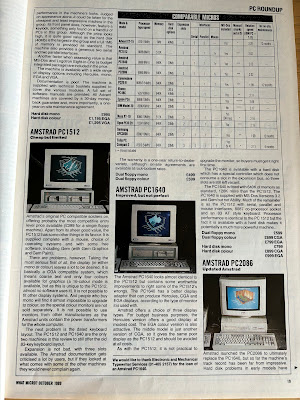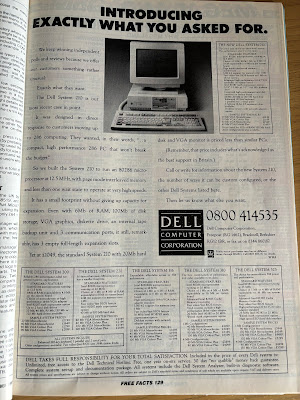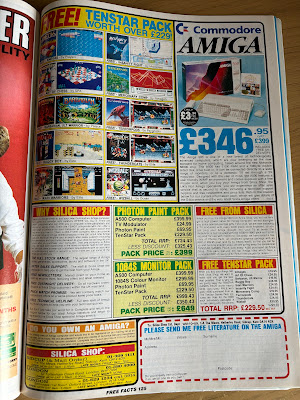 |
| Looking a tad rough with age, I know exactly how this mag feels. |
In the news, Digital Matrix were adding 25 and 30MHz versions to their 386 range, with the base Hercules display equipped model with 1Mb of RAM and 20Mb of hard drive storage for £1,715. A top-specced mono model (2/300 plus 60Mb tape streamer) was yours for £3,760, and a three user system (for what else did one need a 386 for in 1989?), with 4/65, a 40Mb streamer plus two (count 'em) Wyse 120 terminals primed bank manager angst at £4,995! You got SCO Office Portfolio and SCO Xenix 386 included, but that was just for the 25MHz version. An extra 5Mhz would cost £2,310, £4,609 and £5,740 respectively.
Meanwhile, Tandy had a sub-£1k '086 portable sans hard drive for £999 (spinning rust was £700 extra), and Toshiba were bundling a printer worth £345 with their mains-only AT portable, the T1600 for £3,195. What a bargain! If you wanted something capable of use on the move (ish), Packard Bell's PB286LE with 1/20 started at £2,195, combining a 15lb all up weight (complain about an extra 100 grams on you next ultra-portable, why don't you!) and a three hour battery life. I've had Teams meetings last longer than that!
There was also a competition to win a Commodore PC20, complete with MS-DOS, a 20Mb hard disk and a monitor. The same spec machine did rather well in...
... the cover group test for the Top 12 PC's, and the mag defined PC rather tightly - they were talking about the original XT spec and not the later AT (286 and above with high density floppy drives etc) one, and this meant that the dozen desktops on display here were what would be classed as "affordable", as far as 1989 DOS machines went. This truly was the great and the good of the era, and also highlights that for UK home users at this particular point in time, the ST, Amiga and Archimedes were far better all-round machines than any DOS-powered wonder. Amstrad makes up a quarter of the review samples, with their PC1512, PC1640 and the latest 2086, and the reviewer notes the first two machines are definitely long in the tooth but also still capable "budget" computers - the base PC1512 rocks up a mono display and a single floppy for £399. Advent, Commodore, Epson, Elonex, IBM, Opus, NESS, Samsung and Tulip round out the rest to varying degrees of success, The verdict box makes it's very much a buyers choice, but spending anything over a grand here was considered wasteful. There again, the question of whether or not an AT-spec machine would see you right also raises an interesting comment - people who need a mainstream machine for the next five years should consider a 386. What was the saying about never going into the prophecy business? Over the next three years, the £1,000 level barrier would shatter through three processor generations (286, 386 and 486) with surprising ease.
The Mac Portable is next and, it is a doozy of a machine - having seen a real one at the North West Computer Museum, it's a desirable piece of kit even now, though my back wouldn't like me for carrying one. Its size is noted, as is the cost (£4,500 with a hard drive, £4,000 floppy only). Using a different kind of battery tech (lead acid, hence the weight), the off-grid longevity was claimed to be five to eight hours, twelve for the floppy-only model! The 16MHz 68000 made it a speedy Mac, and even though there were similarly pricey DOS options (the 12MHz Zenith Turbosport 386 and Toshiba's T5200 reach and break the £5k barrier), users wanting any kind of portable computer could find cheaper. Just not a Mac.
There's a feature on word processors, how they could help people who wanted to type long documents, what defined the concept of a word processor, and why a PC loaded up with a then-modern day piece of software would be much more useful than any dedicated kit (looking at you, Amstrad PCW). There's hints and tips about formatting, font choices and how to make the most of any word processing software, and for the time, this was very informative stuff.
There were other software options to the dedicated word processor, and this is where the "integrated package" comes in. A round up of six contenders vie for the title of best all-in-one business bundle, offering word processing, databases, spreadsheets (those last two are NOT the same thing!), and maybe some comms capabilities. Prices aren't bad - £36 for the questionably named "The Secretary Bird", to £199 for Ability Plus. Good old 90's bundled favourite Microoft Works tips in at £145. There is no overall winner, just shades of grey recommendations, which is as it should be as each package has its own strengths and weaknesses. Any would see you right for most needs. Just try not to panic at having to spend actual money on what these days are considered "free" applications.
Cost is something to consider when looking at Microsoft Word v5.0, and neatly demonstrates how massively times have changed. £395 would get you the over-sized box complete with a 640-page user's guide, 250-page reference manual, 300-pages on using Word with printers(!), a 30-page pocket guide, a 110-page "ideas" guide, a 10-page newsletter and two advertising leaflets. There's even a six-page road map on how to use the manuals! After buying a new bookcase for this assortment of knowledge, you then have to deal with 13 floppies, and although you can get away with using Word 5 on a dual-floppy machine, it's best to install the bugger, where it harvests 2Mb of space. The overall verdict is that Word 5 is state of the art, but possibly overkill for most. Can't argue with that point of view.
Speaking of cutting edge, Lotus 1-2-3 falls into the version trap with a strangely numbered Release 2.2, coming as it does after Release 3.0. The latter was the all-singing, all-dancing 3D packed 286/386 bothering deity-level app, requiring 4Mb of hard drive space. 2.2, however, was for mere mortals, but still cost £395 (seems a popular price - just less than a billy basic Amstrad PC1512). Upgrades were much cheaper (as little as £35 for some), but the advice is that if you wanted something like Lotus 1-2-3 then Release 3.0 was a much better option and, as such, required you to jump on board the AT bandwagon. Few with XT-class machines would find Release 2.2 good value for money.
Of course, being 1989, whatever serious work you do would need to be shared, and this would primarily involve a printer. Handily, a guide to such decibel deliverers is here for options under £500. The budget level is catered for by 9-pin dot matrix wonders, with listed prices starting at £125. The more capable (I did not say better!) 24-pinners begin at £249. For those of you with only contempt for your hearing, Daisywheel printers offer typewriter levels of quality as well as enough volume to wake the dead. Finally, there are a handful of inkjet and thermal types that will deliver peace and quiet, but not necessarily good quality text or value for money. Not yet, anyway... The recommended models include the Panasonic KX-P1124, the Amstrad LQ5000di (albeit with relatively poor print and very poor build qualities), as well as the ever-present Star LC10, truly the budget connoisseur's 9-pin option.
Finally, there is the Buyer's Guide. After a PC clone, AT-compatibles or portables, this here is your list, and there is a lot to ponder. Many manufacturers, specs and budgets, but as it's 1989, your trip to Dixons would probably net you an Amstrad... Serious software gets a look in too.
The really fun part now: the adverts, and this absolute corker from IBM targets the business user with a rather confident statement about buying one of their latest 486 machines. Well, almost. If you purchased a PS/2 Model 70-A21 386 desktop, you'd be able to swap out the processors when the new fangled three times more powerful Intel chips landed. Cool idea, but considering this ad from Compumart has the expandable 70-A21 at £4,103 excluding VAT, that's some serious moolah to drop on the promise of spending even more money on faster things to come - never mind the reliance on Micro Channel Architecture, nor the fact that a monitor and DOS appears to be extra! Put another way, with VAT, that was £4,718 from a reseller. That amount today equates to a smidge over £12k! You might not get fired for buying IBM, but you could go bankrupt!
NESS is next, and they can start you on an 8088 XT (also covered in the group test) for £695. Although the ad makes zero reference about display options, that's for the mono model. CGA came in at £870, EGA at £990 and the (then) holy grail of VGA at £1,130. You can guess that the 286's would have suitable additions to their prices for colour, and that 386 would be pricey indeed (though far less than an IBM option).
Here's a name that's definitely still with us: Dell. Their base 286 (none of that XT rabble for these legends) starts at £1049 for a mono system. The top of the line System 325 386 is as eye watering as IBM's offering: £5,399 ex VAT for 4Mb of RAM and a 150Mb hard drive. Seriously powerful for the time, but also seriously expensive. The more basic System 325 with 1/90 and mono VGA was still £3,949 ex. One year later, that would be £2,099. A year after that, half again. That's not to say these were over-priced. They were not. I merely point out the changes to evidence the sheer speed of change the PC market underwent between 1989 and 1994.
Megaland, self-proclaimed "specialists in mail order" seemed to have everything and, in a nice touch for personal buyers, published VAT-inclusive prices as well. Both PC's (Samsung, Commodore and Amstrad) and Amigas (B2000 and A500) get a look in, as does the PCW and Commodore C64. It's a useful advert as it offers Amiga A500-based business packs (computer, monitor and printer) for £745 inc, or £853 inc with a half meg RAM upgrade. More expensive than an Amstrad PCW, but so much more capable. The problem the Amiga would have in the next couple of years is that the cost of a hard drive equipped 286 with VGA colour would drop from the £2,146 listed Commodore PC40-III (1/40) to well under a grand. As noted above, the 386 would be snapping at its heels too. Meanwhile, the Amiga and ST stagnated - and no, neither the 68020-powered A1200 nor the ever-so beautiful Falcon '030 could keep up with the advancements in the DOS, later Windows/DOS world. The PC woulds still cost more, but could also do a hell of a lot more - and piss poor management by both Commodore and Atari would doom those companies long before DOOM stamped itself on the PC for gamers.
Speaking of the those UK home computer favourites, we'll end with a pair of Silica ads: one each for the Amiga and the ST. Classics of their time (the computers and the adverts), the 16-bitters had never had it so good. From the viewpoint of October 1989, there was plenty of life left in them and the DOS PC was no competition at all. Ah, the innocence of youth...
Anyway, that's it for 1989. For the next Magazines of Yesteryear, I rather fancy something a little more... niche...
















No comments:
Post a Comment